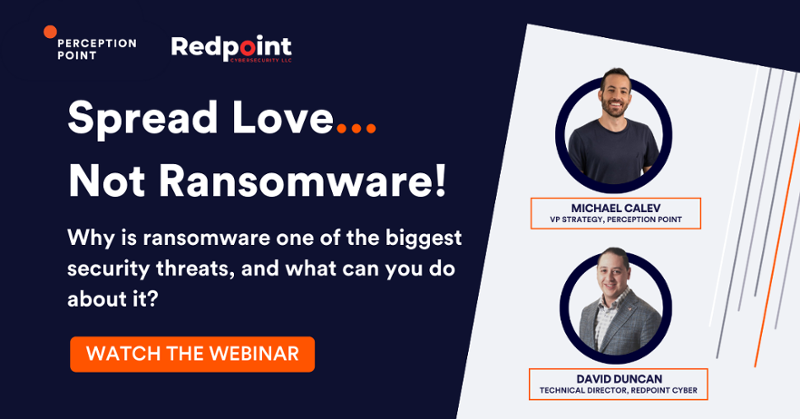In Verizon’s 2021 Data Breach Report, ransomware ranked the second most common malware attack after command and control. Many employees still fall victim to ransomware with work email being its main delivery mechanism. Cyberthreats seem to linger wherever people go, whether on mobile devices or desktops. Which leads organizations to question: How can we strengthen our ransomware prevention plans?
If you don’t have any ransomware prevention plans in place, you have even more reasons to start developing one. Here we share insights on how you can start, and eventually strengthen your cyber risk protection plans.
Implement company-wide security awareness training
Prevention starts with a keen awareness of the problem. Having a high perception of cyberthreats—what they do, how they manifest in emails or texts, and their telltale signs—can help block them before they can do serious damage.
Teach users to recognize cyber threats such as ransomware, phishing, and others. Awareness of social engineering techniques can help reduce risks too. Users trained to recognize malicious messages and content are less likely to open compromised attachments. Everyone is at risk of a ransomware attack. So the more people know how to spot signs of ransomware, the less chance you have of getting invaded.

Tal ZamirCTO, Perception Point
Tal Zamir is a 20-year software industry leader with a track record of solving urgent business challenges by reimagining how technology works.
TIPS FROM THE EXPERTS
- Implement anomaly detection systems. Beyond traditional signature-based detection, consider deploying anomaly detection systems that identify unusual behavior patterns within your network. These systems can flag potential ransomware attacks before they fully execute by noticing deviations from typical user or system behavior.
- Conduct regular ransomware penetration testing. Beyond standard vulnerability assessments, perform ransomware-specific penetration testing. This involves simulating ransomware attacks to assess your organization’s ability to detect, respond to, and recover from such incidents, highlighting gaps that need addressing.
- Establish and rehearse incident response plans. Develop a detailed incident response plan specifically for ransomware events and conduct regular drills. Include steps for containment, eradication, and recovery, ensuring that all stakeholders know their roles. Rehearse these plans regularly to identify weaknesses in your response strategy.
- Integrate behavioral-based email security solutions. Instead of relying solely on signature-based email filtering, integrate solutions that use behavioral analysis to detect unusual email activity patterns, such as unexpected attachments or links, which are common in ransomware delivery mechanisms.
Keep offline & online backups of your data
Virtual backups are essential to safeguarding your operations. Benefits of switching to cloud collaboration channels range from higher work efficiency to data security. Unfortunately, it is not 100% fool-proof.
Relying on virtual backups alone might do more harm than good. Keep multiple backups in case your live and virtual data is compromised. And when choosing a cloud storage provider, go with vendors that have a proven track record of protection.
Deploy State of the Art Security Solutions for Prevention
Despite the availability of so many security solutions on the market, many organizations remain exposed to advanced phishing, malware, ransomware, BEC, ATO and zero-day attacks. Traditional security systems are unable to deal with the evermore sophisticated methods of threat actors.
For detecting advanced malware and ransomware, traditional sandboxing technology has become outdated and not up to par to meet the challenges posed by sophisticated hackers, who employ several levels of attacks with multiple evasion techniques. They are also slow and inefficient, and cannot be used for proper prevention.
Advanced Phishing and BEC attacks are not efficiently detected by traditional systems and require AI and ML to identify sophisticated attacks before they reach the end user.
Update regularly
Operating systems, software, and applications become more vulnerable the more out of date they become. Cyber attackers, however, are always working on new ways to break those systems down. Stay one step ahead of them by making sure your systems are all up-to-date.
Enable auto-updates on all of your software and applications to make sure you always have the most recent version. Patch vulnerabilities and whitelist applications to bolster your ransomware prevention practices.
Set password management policies
Over 90% of small and medium businesses have some combination of stolen account credentials for sale on the Dark Web. Reduce the chances of hackers successfully infiltrating confidential data with proper password management.
Provide as little privilege as possible. Use strong access management to limit unauthorized users and reduce the number of entry points for malware into your organization. You can also set up more layers of protection like multi-factor authentication and role-based access control.
Keep an eye out for new threats
Ransomware attacks are constantly evolving. Monitor and learn about the latest trends to make sure you are one step ahead.
Consistent monitoring, frequent file backups, fast detection, and user training are some of the key ingredients to strong ransomware prevention. No cyber-defense is 100% fail-safe, but with these measures, you can reduce the likelihood that attackers will be successful.
Perception Point has a rich archive of resources on how to strengthen your ransomware prevention. Check them out to learn more today.

Here are ways you can start, and eventually strengthen, your cyber risk protection plans:
– Implement company-wide security awareness training
– Keep offline & online backups of your data
– Deploy State of the Art Security Solutions for Prevention
– Update operating systems, software, and applications regularly
– Set password management policies
– Keep an eye out for new threats
























